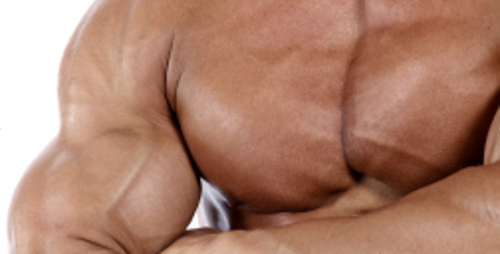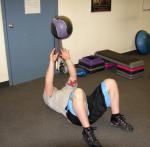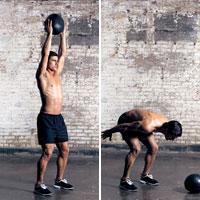Plyometrics is a great training tool that combines speed and strength. Other benefits of doing plyometrics are well-defined muscles and a higher metabolism for hours after the workout. For many years people have thought of plyometrics solely as a training tool for athletes, but now bodybuilders, fitness models, and workout enthusiasts are all adding it into their training programs.
Usually, when you think of plyometrics, you think of lower body exercises. However, today we are going to focus on the upper body to get a well-defined chest and abdominals. Mixing plyometrics into your upper body routine can also prevent overtraining and increase your overall strength.

This form of explosive movements uses the stretch shortening cycle. In short, plyometrics forces the muscles to stretch rapidly before the concentric (shortening) movement, which uses stored elastic energy and makes the movement much more forceful than if the rapid stretching did not occur.
Safety When Performing Plyometrics
When performing these high intensity exercises, it is important to be aware of proper execution to prevent injury. Always warm up and stretch prior to any plyometric training.
As soon as form is jeopardized, stop the movement. Plyometrics should not be performed in high repetitions. Low repetitions followed by a full rest period allows your muscles to perform at optimal levels. The American Council on Exercise (ACE) recommends, “quality, not quantity” when performing these movements.
For upper body plyometrics, have a spotter work with you to make sure nothing goes wrong. Also, remember to breathe throughout the movements and to keep your core muscles tight.
Ready to Feel the Burn?
 Medicine Ball Throws – Lie with back on a bench and feet either flat on bench with knees bent or flat on the floor with lower back touching the bench. It is very important to keep your core muscles tight throughout the entire movement. Hold the medicine ball with both hands, tight into your chest, with elbows out. Now push and throw the medicine ball up towards the ceiling as hard as you can. Then catch the medicine ball. As you catch the ball, let it come close to your chest and then power it up again. Repeat 5 to 8 times and rest.
Medicine Ball Throws – Lie with back on a bench and feet either flat on bench with knees bent or flat on the floor with lower back touching the bench. It is very important to keep your core muscles tight throughout the entire movement. Hold the medicine ball with both hands, tight into your chest, with elbows out. Now push and throw the medicine ball up towards the ceiling as hard as you can. Then catch the medicine ball. As you catch the ball, let it come close to your chest and then power it up again. Repeat 5 to 8 times and rest.
Note: With this exercise you should always aim to go heavy. Athletes typically use 40 to 60 pound medicine balls, while bodybuilders and power lifters can use up to 100 pounds. The weight is important because it gets the deep stretch needed to use optimal force to explode the ball upwards.
Smith Bar Throws — Stand with feet slightly wider than shoulder width apart in the Smith machine facing out. Knees should be slightly bent and abs nice and tight. Grab the bar with hands shoulder-width apart or slightly wider. With elbows bent down by sides and hips back slightly, push the bar up with as much power as you can create. Then bring it down, allowing your hands to give with the motion. Immediately propel the bar back into the air. Repeat for 5 to 8 reps.
Note: When performing this exercise you should use 30 – 45% of your 1-2 RM. This weight will allow proper stretching and challenge your muscles while you are exerting maximum force. I also recommend a spotter for this exercise.
Side Medicine Ball Throws – Stand with feet slightly wider than shoulder width apart. Have left side facing a sturdy wall, with left foot on a slight angle outward. Make sure knees are relaxed and abdominal muscles are tight. Hold medicine ball in front right below chest level, with your elbows bent. Now keeping upper torso still, swing ball to right and then throw the medicine ball as hard as you can towards the wall. Catch and immediately give with the ball so it comes right again and then throw back at the wall. Keep repeating and then switch sides.
This exercise can be done with a partner as well. The partner should catch the ball and immediately throw it back.
 Overhead Medicine Ball Slams – Stand with feet tight together. Thighs should be touching, and abdominal muscles should be tight with shoulders relaxed. Hold medicine ball in front of you. Now slam the medicine ball down on your right side as hard as you can. Catch the ball and bring it up over your head with straightened arms and slam down on opposite side. Aim to slam the medicine ball about one foot away from your body so you are forced to reach for it slightly. It is very important to keep your legs tight together and really engage the core muscles. Keep repeating the slams from side to side.
Overhead Medicine Ball Slams – Stand with feet tight together. Thighs should be touching, and abdominal muscles should be tight with shoulders relaxed. Hold medicine ball in front of you. Now slam the medicine ball down on your right side as hard as you can. Catch the ball and bring it up over your head with straightened arms and slam down on opposite side. Aim to slam the medicine ball about one foot away from your body so you are forced to reach for it slightly. It is very important to keep your legs tight together and really engage the core muscles. Keep repeating the slams from side to side.
Band Push-Ups — I am sure you have heard of the common push up with clap in the middle exercise. This exercise is a great plyometric drill but some people lack the strength to push up far enough to get a clap in. With the band push-up, the person’s body weight is reduced so that the explosive movement can be performed.
Secure the bands overhead on a piece of equipment or something sturdy. Then attach to or wrap around your armpits, your back legs should be on a bench to give you proper leverage. Because you have taken some of your body weight away, you will not be able to perform at maximal or near maximal power.
With arms secure in elastic bands, get into push-up position. Back feet can be on bench or the floor. Now allow yourself to drop down as far as possible, then push your body away from the floor as high as you can. Return to floor and allow the body to drop and then repeat, immediately. Continue for 5 to 8 repetitions and then rest.
Maximal Effort Equals Maximum Definition
All three exercises are great additions to any chest workout. These exercises will challenge the muscles optimal output as well as increase strength and power. “Make sure to use speed in both the eccentric and concentric phase,” states the National Strength and Conditioning Association (NSCA).
Also, when giving maximal effort you should perform only 5 to 8 repetitions of each exercise for 3 to 5 sets. The rest period should allow full recovery between sets. If you do more you will start to jeopardize form and function. If these exercises are too easy then increase the weight; it should be hard to finish the last set.
Plylometrics not only trains your power and strength but also burns tons of calories during and after! Adding plyometrics to your strength routine can burn the same amount of calories in 30 minutes that a normal workout would in 60 minutes. Start training your upper body differently and see maximal results and a leaner you!

